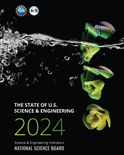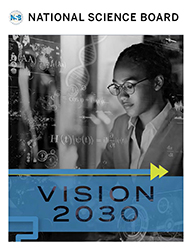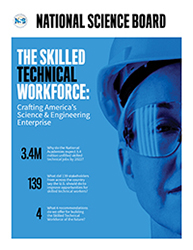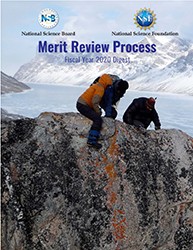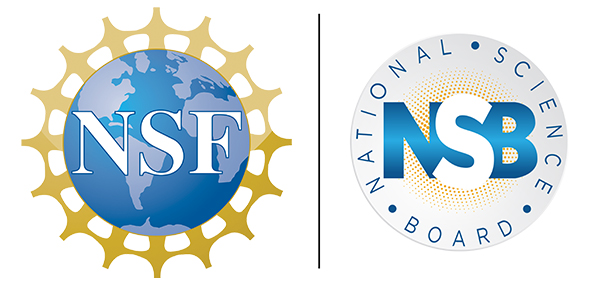
Science, engineering, health doctorates find success in wide range of job sectors
New infographic lets users explore career paths for doctoral recipients.
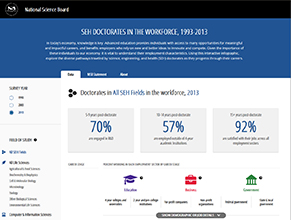
SEH Doctorates in the workforce, 2002-2013 (Credit and Larger Version)
April 19, 2017
With the release of a new Policy Brief featuring an interactive infographic, the National Science Board (NSB) provides a powerful new tool for policymakers, educators, business leaders, students, and others to assess the career opportunities for those with doctoral degrees in Science, Engineering, and Health (SEH) fields. The infographic allows users to see the number of doctorates employed in business, government and academic jobs and how career paths change over time.
“We need to exorcise the notion that those who get a PhD in a Science, Engineering, or Health field are limited to an academic career,” said Geraldine Richmond, Chair of NSB’s National Science and Engineering Policy Committee and lead in developing the Brief. “The data show incredibly diverse jobs that PhD holders are in across all employment sectors. It’s our hope that this brief helps raise awareness in students and faculty about the rich and varied career paths that these doctorates can take.”
The infographic takes a deeper look at a key issue the NSB raised two years ago when it released its report, Revisiting the STEM Workforce. That report highlighted the need for a STEM-capable workforce in today’s knowledge economy. It also showed that a degree in science and engineering can be a “passport” to a wide range of professions and that over half of these degree holders work in non-STEM jobs.
Using data from the Survey of Doctorate Recipients (SDR), NSB’s infographic lets users explore where doctorates in 26 SEH fields are employed across job sectors in education, business, and government, and to see how that changes with time. Users can also look at demographics, including gender, and race and ethnicity; and at characteristics such as job duties and job satisfaction. Data can be downloaded and the visualizations exported.
Key findings include:
- More than 50% of SEH doctorates are employed in professions outside of academia within 10-14 years of graduating. This has been the case for more than 20 years.
- Over 90% of respondents report job satisfaction 15+ years after getting their doctorate.
- Employment sectors into which individuals go early and mid-career varies by field of degree. For example, the career pathways of social scientists are very different from that of engineers.
- The majority of recent doctoral graduates engage in research and development, regardless of employment sector.
- As their career progresses, PhD degree holders engage in other activities such as management.
Several National Science Foundation (NSF) initiatives aim to help students transition from graduate studies to the workforce. These include the Graduate Research Internship Program, which provides NSF Graduate Research Fellows with federal government internships, I-Corps, which helps researchers identify potential commercial opportunities that arise from NSF-funded research, and the Research Traineeship Program, which seeks to provide students with the skills, knowledge, and competencies they need for a range of careers.
About the National Science Board
Jointly the NSB and the Director pursue the goals and function of the NSF. The Director is the ex-officio 25th member of the NSB. The NSB establishes NSF policies within the framework of applicable national policies set forth by the President and Congress. NSB identifies issues critical to NSF's future, approves the agency's strategic budget direction and the annual budget submission to the Office of Management and Budget, and new major programs and awards. The NSB also provides the President and Congress with a biennial report on U.S. progress in science and technology, Science and Engineering Indicators, providing comparisons to other nations in the areas of research and development, STEM education, and workforce training. The President appoints Board members for six-year terms and may reappoint members for a second term. Members are drawn primarily from universities and industry and selected for their eminence in research, education, and records of distinguished service. Collectively, the Board represents a variety of science and engineering disciplines and regions across the United States.
Media Contact
Nadine Lymn, National Science Board, (703) 292-2490, nlymn@nsf.gov
Useful NSB Web Sites:
Home Page: http://www.nsf.gov/nsb
Media Contact: http://www.nsf.gov/staff/staff_bio.jsp?lan=nlymn&org=NSF
News: http://www.nsf.gov/nsb/news
Meetings: http://www.nsf.gov/nsb/meetings
Publications: http://www.nsf.gov/nsb/publications
Facebook: https://www.facebook.com/NationalScienceBoard
Twitter: Twitter: https://twitter.com/intent/user?screen_name=NSF_NSB
YouTube: https://www.youtube.com/channel/UCkrHRzuGSrPp2haQs0T_Pww
To view PDF documents, please download Adobe Acrobat Reader.
